The Impact of HR Practices on Employee Retention in the F&B Industry
VerifiedAdded on 2023/06/10
|23
|4366
|240
Report
AI Summary
This research project investigates the impact of HR practices on employee retention within the food and beverage (F&B) industry in Qatar. The study begins with a comprehensive literature review, exploring the concept of employee retention, reasons for employee turnover, and relevant models such as Mobley's Model. It examines various HR practices, including skill recognition, job flexibility, training, superior-subordinate relationships, and communication. The research design employs a descriptive approach using primary data collected through a probability sampling technique with a sample size of 100 employees from the Qatar F&B sector. The report outlines the strengths and limitations of the chosen research design and the ethical considerations involved in data collection. The findings of this research are aimed at identifying the key drivers of employee turnover and recommending effective HR strategies to enhance retention rates in the competitive Qatari market.
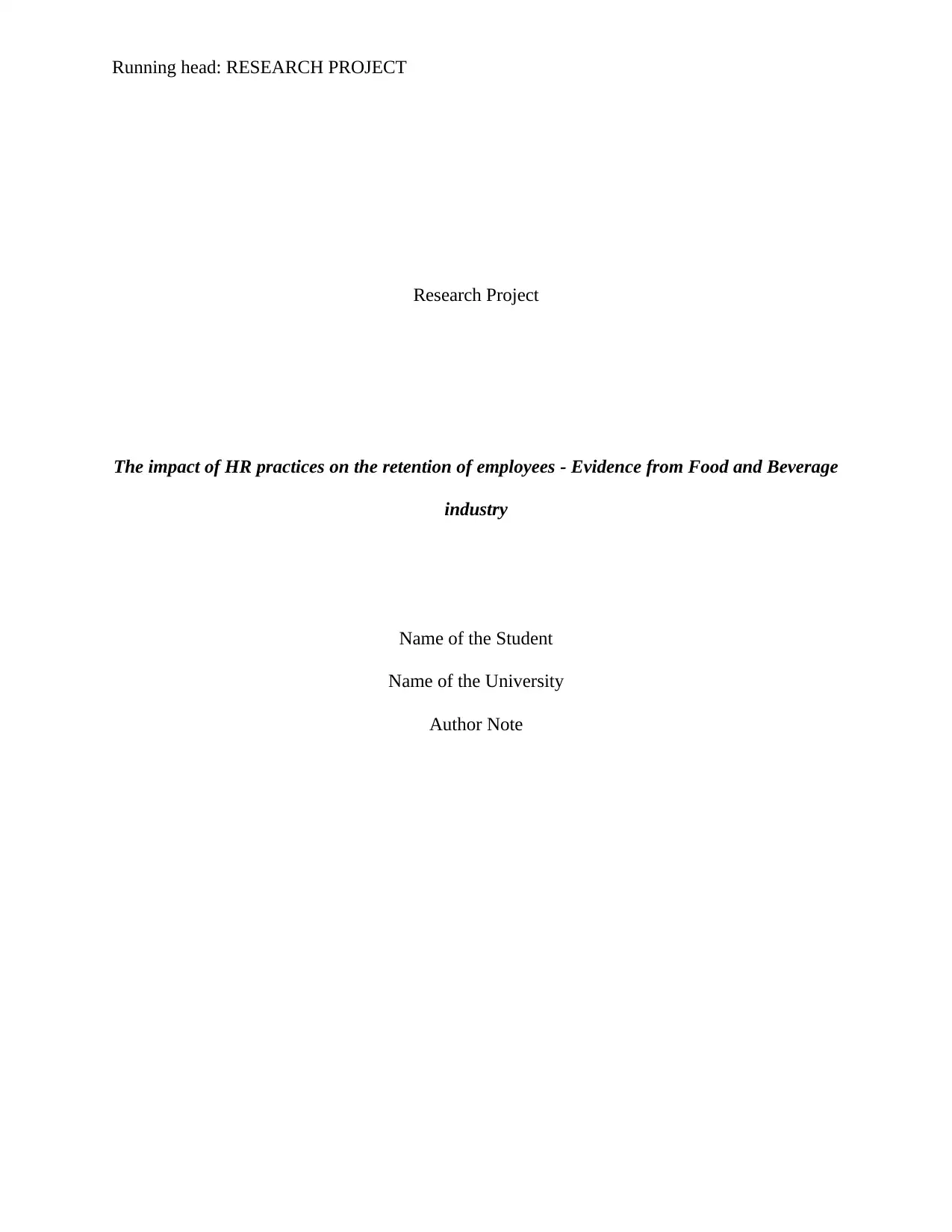
Running head: RESEARCH PROJECT
Research Project
The impact of HR practices on the retention of employees - Evidence from Food and Beverage
industry
Name of the Student
Name of the University
Author Note
Research Project
The impact of HR practices on the retention of employees - Evidence from Food and Beverage
industry
Name of the Student
Name of the University
Author Note
Paraphrase This Document
Need a fresh take? Get an instant paraphrase of this document with our AI Paraphraser
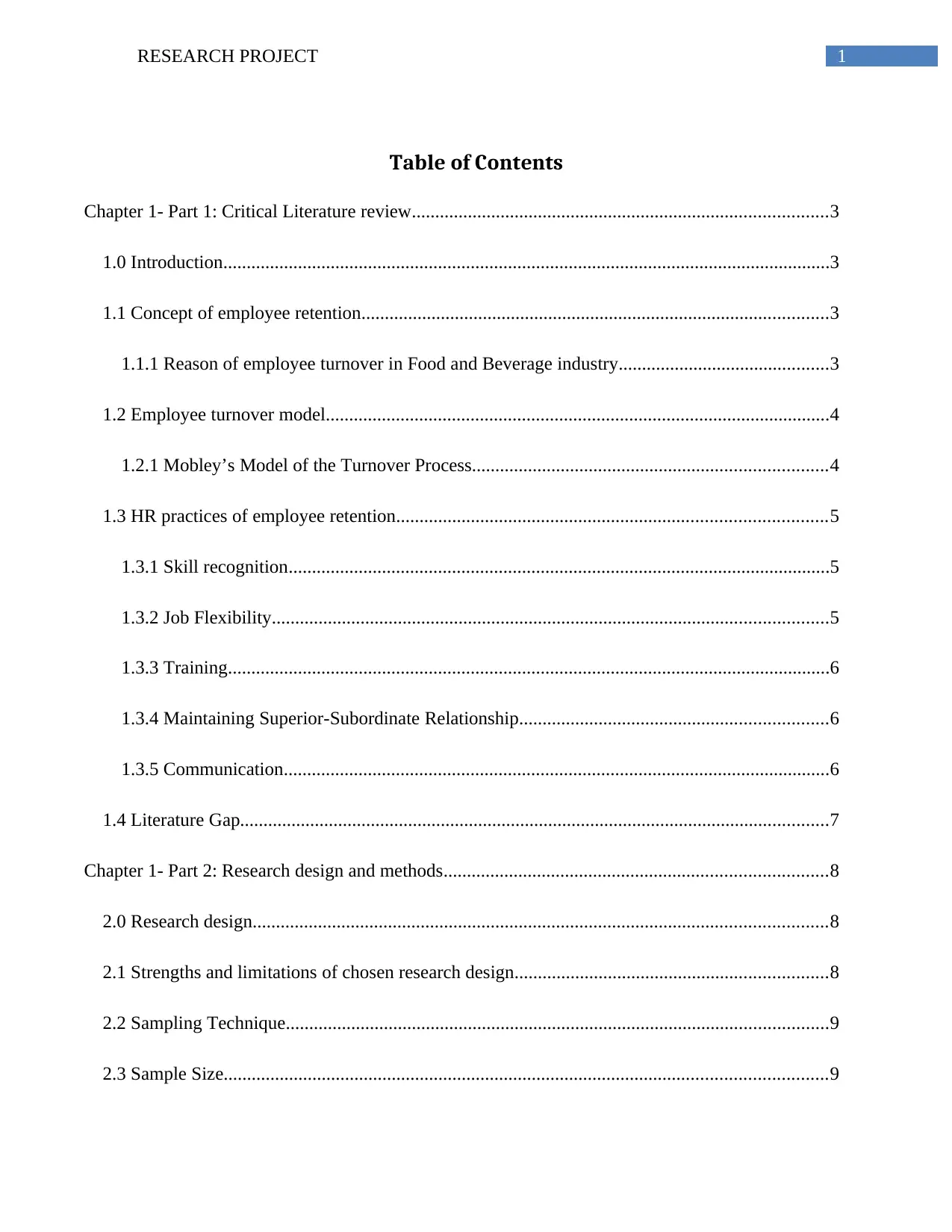
1RESEARCH PROJECT
Table of Contents
Chapter 1- Part 1: Critical Literature review.........................................................................................3
1.0 Introduction..................................................................................................................................3
1.1 Concept of employee retention....................................................................................................3
1.1.1 Reason of employee turnover in Food and Beverage industry.............................................3
1.2 Employee turnover model............................................................................................................4
1.2.1 Mobley’s Model of the Turnover Process............................................................................4
1.3 HR practices of employee retention............................................................................................5
1.3.1 Skill recognition....................................................................................................................5
1.3.2 Job Flexibility.......................................................................................................................5
1.3.3 Training.................................................................................................................................6
1.3.4 Maintaining Superior-Subordinate Relationship..................................................................6
1.3.5 Communication.....................................................................................................................6
1.4 Literature Gap..............................................................................................................................7
Chapter 1- Part 2: Research design and methods..................................................................................8
2.0 Research design...........................................................................................................................8
2.1 Strengths and limitations of chosen research design...................................................................8
2.2 Sampling Technique....................................................................................................................9
2.3 Sample Size.................................................................................................................................9
Table of Contents
Chapter 1- Part 1: Critical Literature review.........................................................................................3
1.0 Introduction..................................................................................................................................3
1.1 Concept of employee retention....................................................................................................3
1.1.1 Reason of employee turnover in Food and Beverage industry.............................................3
1.2 Employee turnover model............................................................................................................4
1.2.1 Mobley’s Model of the Turnover Process............................................................................4
1.3 HR practices of employee retention............................................................................................5
1.3.1 Skill recognition....................................................................................................................5
1.3.2 Job Flexibility.......................................................................................................................5
1.3.3 Training.................................................................................................................................6
1.3.4 Maintaining Superior-Subordinate Relationship..................................................................6
1.3.5 Communication.....................................................................................................................6
1.4 Literature Gap..............................................................................................................................7
Chapter 1- Part 2: Research design and methods..................................................................................8
2.0 Research design...........................................................................................................................8
2.1 Strengths and limitations of chosen research design...................................................................8
2.2 Sampling Technique....................................................................................................................9
2.3 Sample Size.................................................................................................................................9
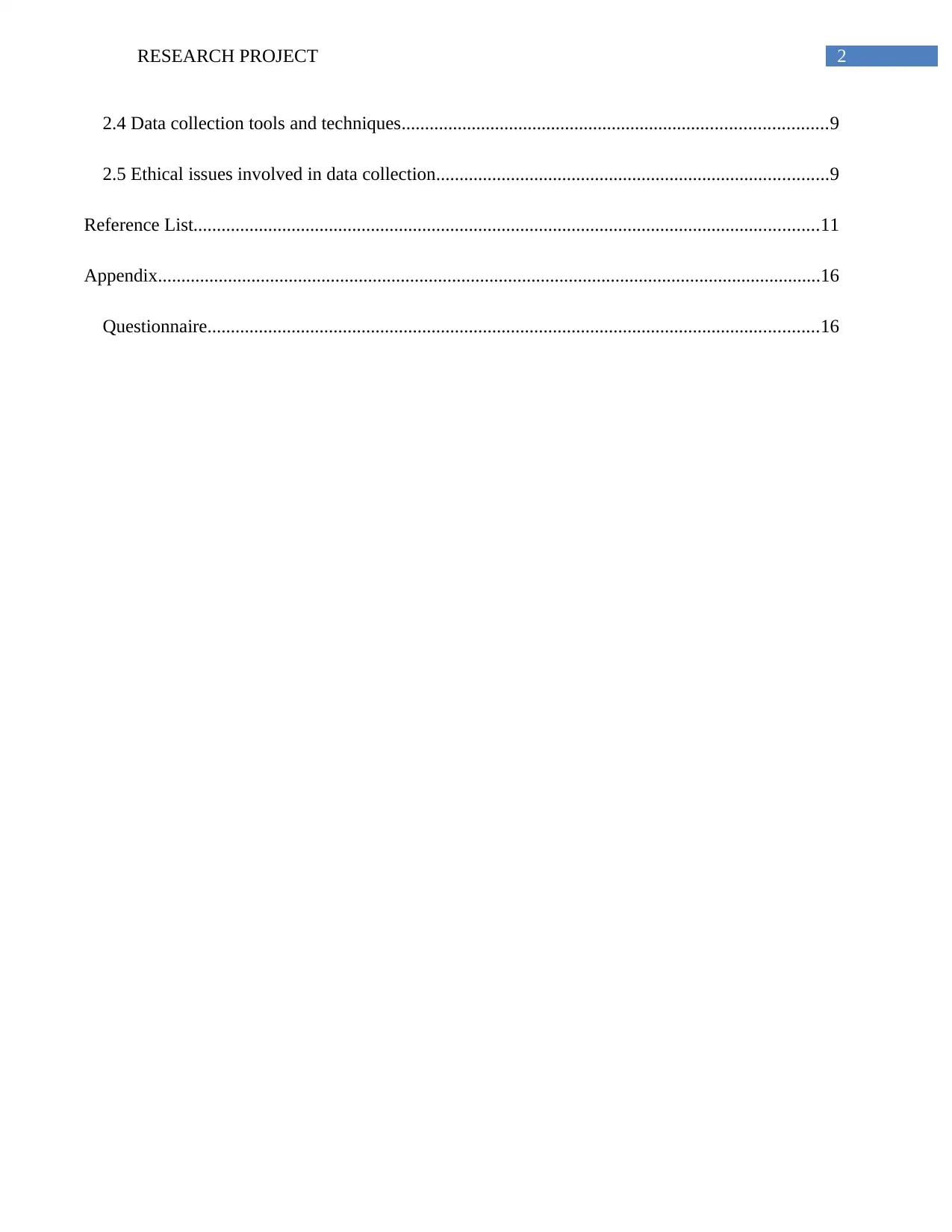
2RESEARCH PROJECT
2.4 Data collection tools and techniques...........................................................................................9
2.5 Ethical issues involved in data collection....................................................................................9
Reference List......................................................................................................................................11
Appendix..............................................................................................................................................16
Questionnaire...................................................................................................................................16
2.4 Data collection tools and techniques...........................................................................................9
2.5 Ethical issues involved in data collection....................................................................................9
Reference List......................................................................................................................................11
Appendix..............................................................................................................................................16
Questionnaire...................................................................................................................................16
⊘ This is a preview!⊘
Do you want full access?
Subscribe today to unlock all pages.

Trusted by 1+ million students worldwide
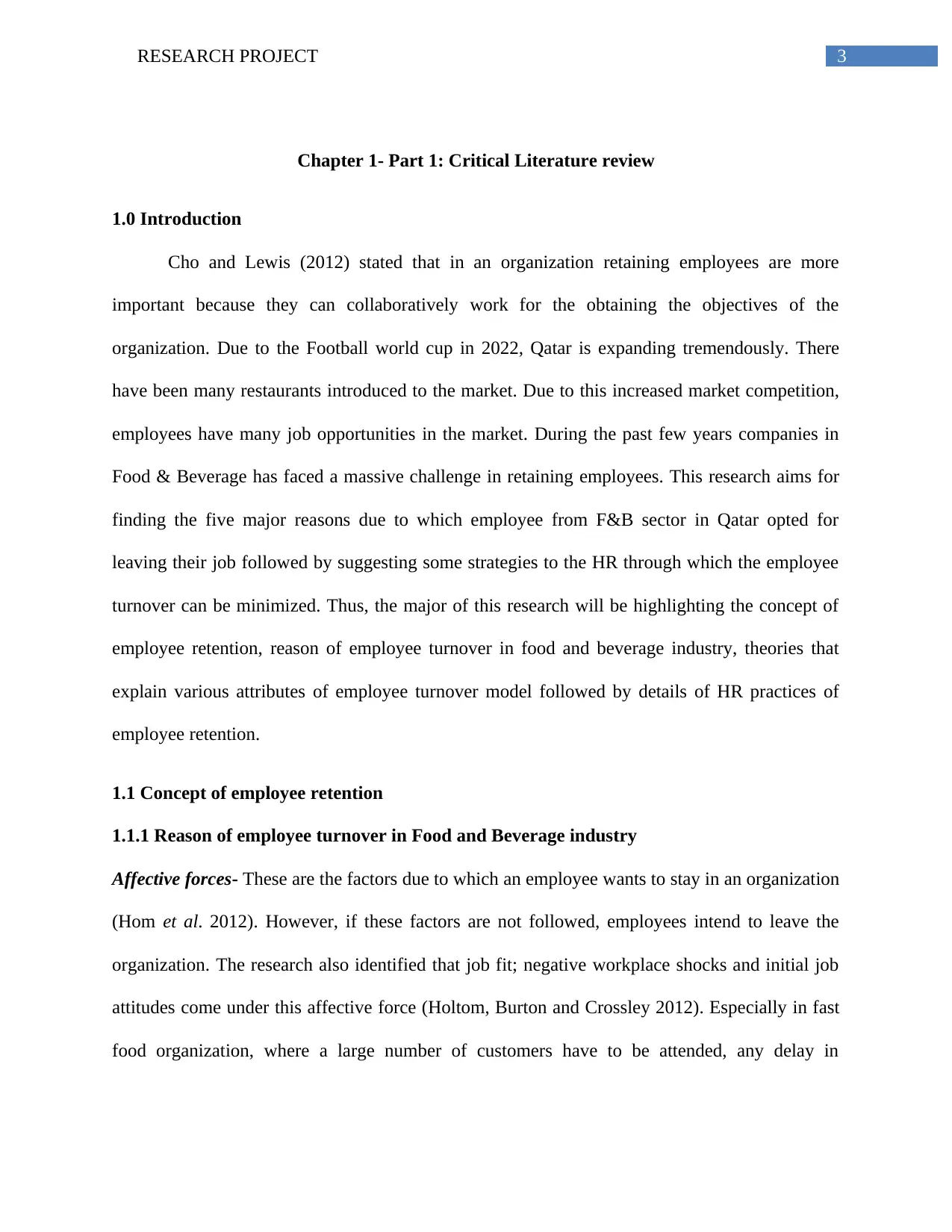
3RESEARCH PROJECT
Chapter 1- Part 1: Critical Literature review
1.0 Introduction
Cho and Lewis (2012) stated that in an organization retaining employees are more
important because they can collaboratively work for the obtaining the objectives of the
organization. Due to the Football world cup in 2022, Qatar is expanding tremendously. There
have been many restaurants introduced to the market. Due to this increased market competition,
employees have many job opportunities in the market. During the past few years companies in
Food & Beverage has faced a massive challenge in retaining employees. This research aims for
finding the five major reasons due to which employee from F&B sector in Qatar opted for
leaving their job followed by suggesting some strategies to the HR through which the employee
turnover can be minimized. Thus, the major of this research will be highlighting the concept of
employee retention, reason of employee turnover in food and beverage industry, theories that
explain various attributes of employee turnover model followed by details of HR practices of
employee retention.
1.1 Concept of employee retention
1.1.1 Reason of employee turnover in Food and Beverage industry
Affective forces- These are the factors due to which an employee wants to stay in an organization
(Hom et al. 2012). However, if these factors are not followed, employees intend to leave the
organization. The research also identified that job fit; negative workplace shocks and initial job
attitudes come under this affective force (Holtom, Burton and Crossley 2012). Especially in fast
food organization, where a large number of customers have to be attended, any delay in
Chapter 1- Part 1: Critical Literature review
1.0 Introduction
Cho and Lewis (2012) stated that in an organization retaining employees are more
important because they can collaboratively work for the obtaining the objectives of the
organization. Due to the Football world cup in 2022, Qatar is expanding tremendously. There
have been many restaurants introduced to the market. Due to this increased market competition,
employees have many job opportunities in the market. During the past few years companies in
Food & Beverage has faced a massive challenge in retaining employees. This research aims for
finding the five major reasons due to which employee from F&B sector in Qatar opted for
leaving their job followed by suggesting some strategies to the HR through which the employee
turnover can be minimized. Thus, the major of this research will be highlighting the concept of
employee retention, reason of employee turnover in food and beverage industry, theories that
explain various attributes of employee turnover model followed by details of HR practices of
employee retention.
1.1 Concept of employee retention
1.1.1 Reason of employee turnover in Food and Beverage industry
Affective forces- These are the factors due to which an employee wants to stay in an organization
(Hom et al. 2012). However, if these factors are not followed, employees intend to leave the
organization. The research also identified that job fit; negative workplace shocks and initial job
attitudes come under this affective force (Holtom, Burton and Crossley 2012). Especially in fast
food organization, where a large number of customers have to be attended, any delay in
Paraphrase This Document
Need a fresh take? Get an instant paraphrase of this document with our AI Paraphraser
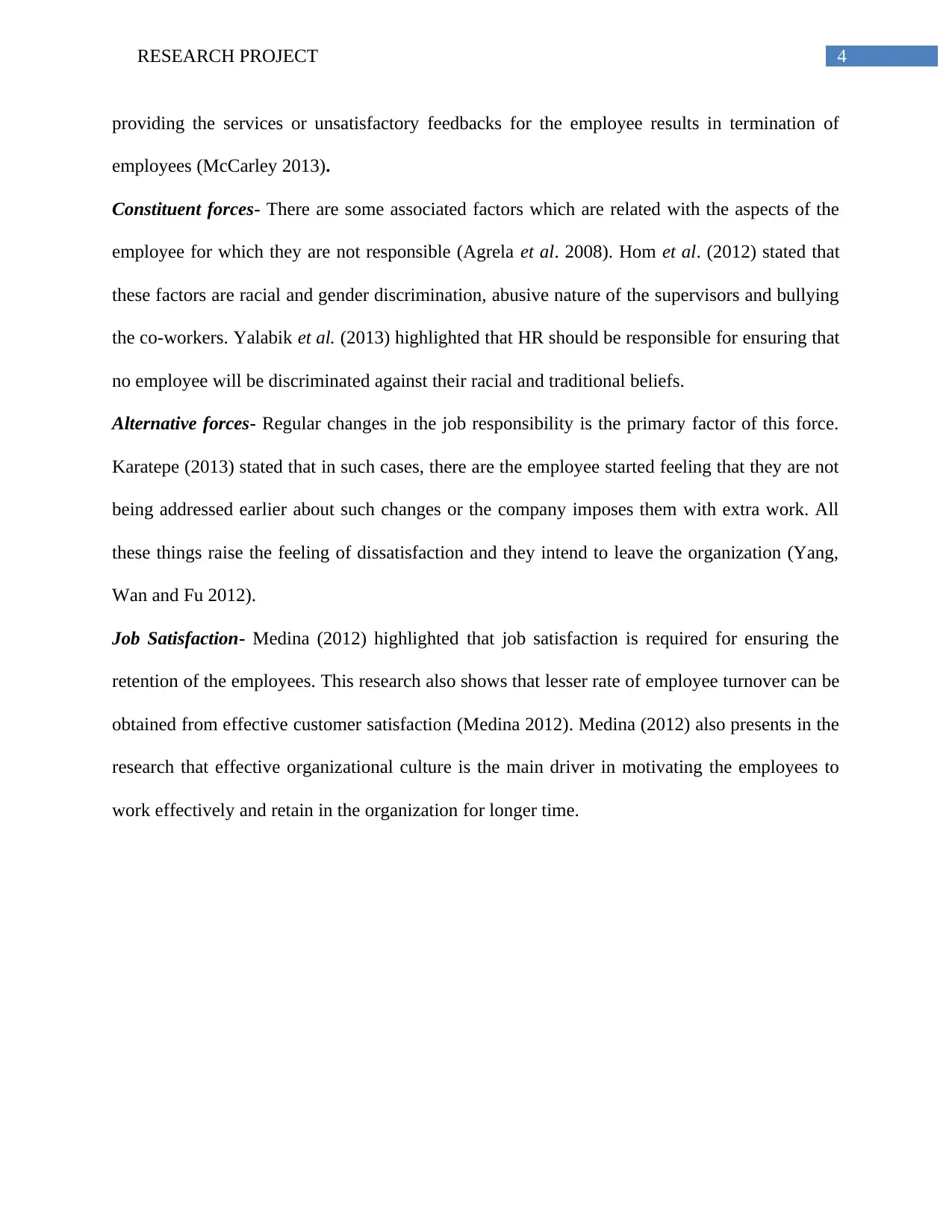
4RESEARCH PROJECT
providing the services or unsatisfactory feedbacks for the employee results in termination of
employees (McCarley 2013).
Constituent forces- There are some associated factors which are related with the aspects of the
employee for which they are not responsible (Agrela et al. 2008). Hom et al. (2012) stated that
these factors are racial and gender discrimination, abusive nature of the supervisors and bullying
the co-workers. Yalabik et al. (2013) highlighted that HR should be responsible for ensuring that
no employee will be discriminated against their racial and traditional beliefs.
Alternative forces- Regular changes in the job responsibility is the primary factor of this force.
Karatepe (2013) stated that in such cases, there are the employee started feeling that they are not
being addressed earlier about such changes or the company imposes them with extra work. All
these things raise the feeling of dissatisfaction and they intend to leave the organization (Yang,
Wan and Fu 2012).
Job Satisfaction- Medina (2012) highlighted that job satisfaction is required for ensuring the
retention of the employees. This research also shows that lesser rate of employee turnover can be
obtained from effective customer satisfaction (Medina 2012). Medina (2012) also presents in the
research that effective organizational culture is the main driver in motivating the employees to
work effectively and retain in the organization for longer time.
providing the services or unsatisfactory feedbacks for the employee results in termination of
employees (McCarley 2013).
Constituent forces- There are some associated factors which are related with the aspects of the
employee for which they are not responsible (Agrela et al. 2008). Hom et al. (2012) stated that
these factors are racial and gender discrimination, abusive nature of the supervisors and bullying
the co-workers. Yalabik et al. (2013) highlighted that HR should be responsible for ensuring that
no employee will be discriminated against their racial and traditional beliefs.
Alternative forces- Regular changes in the job responsibility is the primary factor of this force.
Karatepe (2013) stated that in such cases, there are the employee started feeling that they are not
being addressed earlier about such changes or the company imposes them with extra work. All
these things raise the feeling of dissatisfaction and they intend to leave the organization (Yang,
Wan and Fu 2012).
Job Satisfaction- Medina (2012) highlighted that job satisfaction is required for ensuring the
retention of the employees. This research also shows that lesser rate of employee turnover can be
obtained from effective customer satisfaction (Medina 2012). Medina (2012) also presents in the
research that effective organizational culture is the main driver in motivating the employees to
work effectively and retain in the organization for longer time.
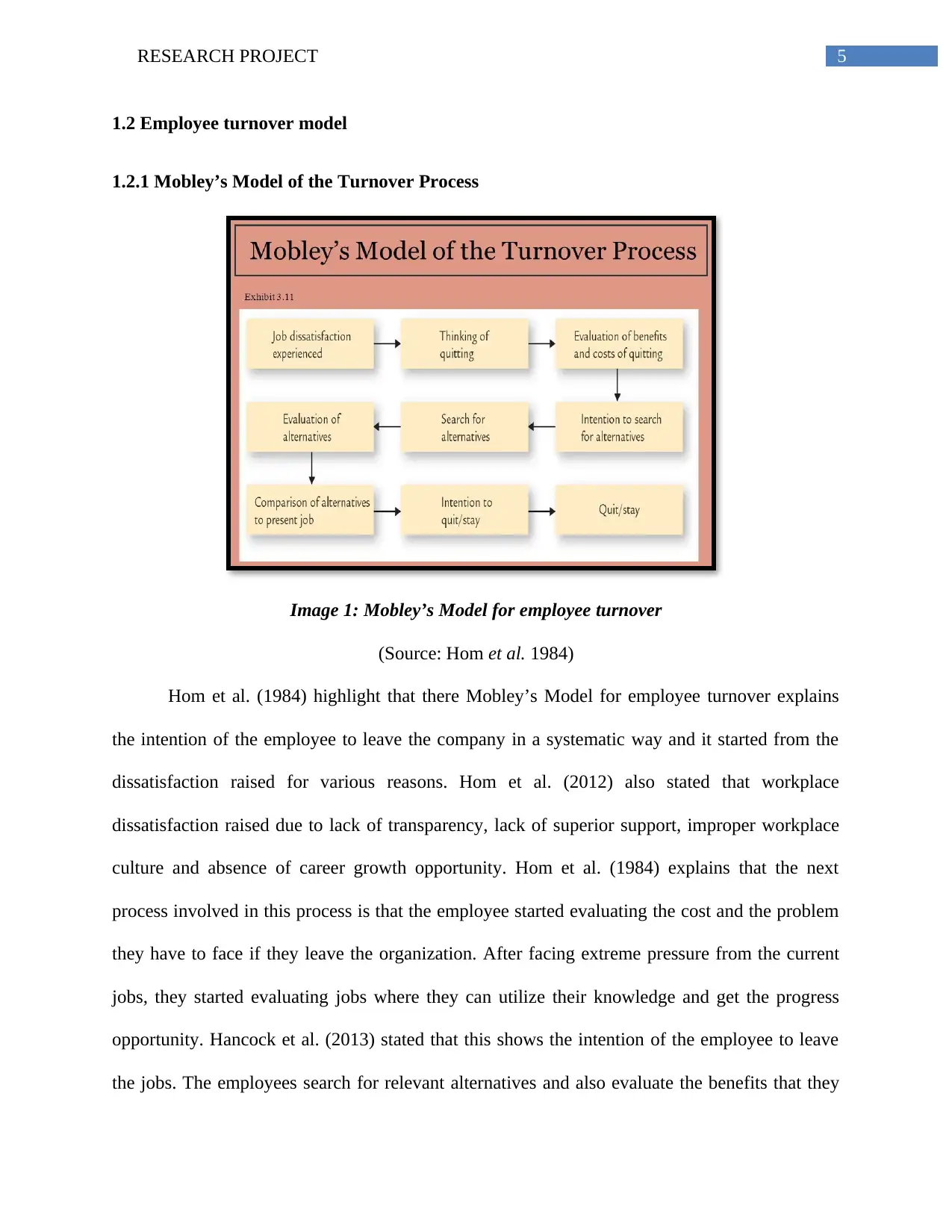
5RESEARCH PROJECT
1.2 Employee turnover model
1.2.1 Mobley’s Model of the Turnover Process
Image 1: Mobley’s Model for employee turnover
(Source: Hom et al. 1984)
Hom et al. (1984) highlight that there Mobley’s Model for employee turnover explains
the intention of the employee to leave the company in a systematic way and it started from the
dissatisfaction raised for various reasons. Hom et al. (2012) also stated that workplace
dissatisfaction raised due to lack of transparency, lack of superior support, improper workplace
culture and absence of career growth opportunity. Hom et al. (1984) explains that the next
process involved in this process is that the employee started evaluating the cost and the problem
they have to face if they leave the organization. After facing extreme pressure from the current
jobs, they started evaluating jobs where they can utilize their knowledge and get the progress
opportunity. Hancock et al. (2013) stated that this shows the intention of the employee to leave
the jobs. The employees search for relevant alternatives and also evaluate the benefits that they
1.2 Employee turnover model
1.2.1 Mobley’s Model of the Turnover Process
Image 1: Mobley’s Model for employee turnover
(Source: Hom et al. 1984)
Hom et al. (1984) highlight that there Mobley’s Model for employee turnover explains
the intention of the employee to leave the company in a systematic way and it started from the
dissatisfaction raised for various reasons. Hom et al. (2012) also stated that workplace
dissatisfaction raised due to lack of transparency, lack of superior support, improper workplace
culture and absence of career growth opportunity. Hom et al. (1984) explains that the next
process involved in this process is that the employee started evaluating the cost and the problem
they have to face if they leave the organization. After facing extreme pressure from the current
jobs, they started evaluating jobs where they can utilize their knowledge and get the progress
opportunity. Hancock et al. (2013) stated that this shows the intention of the employee to leave
the jobs. The employees search for relevant alternatives and also evaluate the benefits that they
⊘ This is a preview!⊘
Do you want full access?
Subscribe today to unlock all pages.

Trusted by 1+ million students worldwide
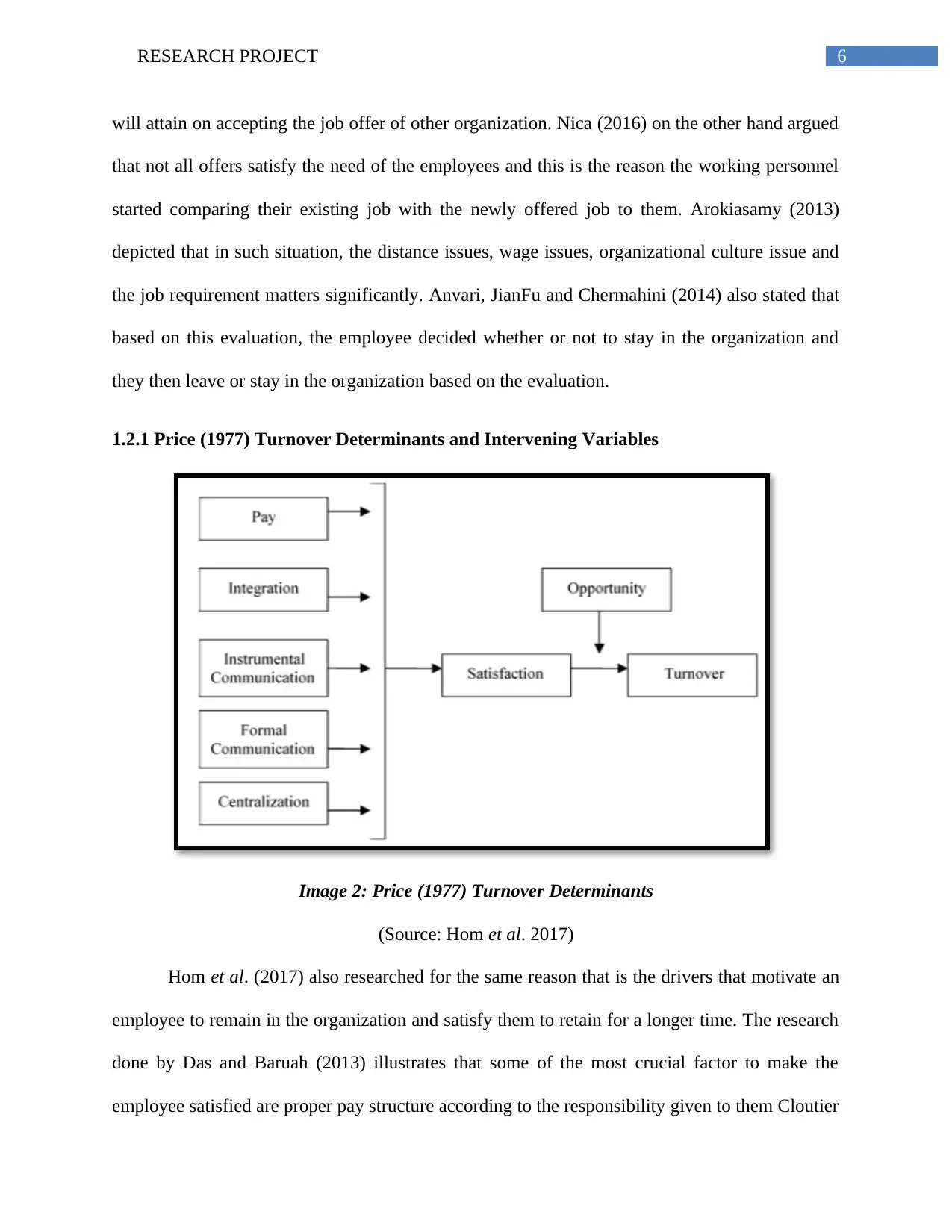
6RESEARCH PROJECT
will attain on accepting the job offer of other organization. Nica (2016) on the other hand argued
that not all offers satisfy the need of the employees and this is the reason the working personnel
started comparing their existing job with the newly offered job to them. Arokiasamy (2013)
depicted that in such situation, the distance issues, wage issues, organizational culture issue and
the job requirement matters significantly. Anvari, JianFu and Chermahini (2014) also stated that
based on this evaluation, the employee decided whether or not to stay in the organization and
they then leave or stay in the organization based on the evaluation.
1.2.1 Price (1977) Turnover Determinants and Intervening Variables
Image 2: Price (1977) Turnover Determinants
(Source: Hom et al. 2017)
Hom et al. (2017) also researched for the same reason that is the drivers that motivate an
employee to remain in the organization and satisfy them to retain for a longer time. The research
done by Das and Baruah (2013) illustrates that some of the most crucial factor to make the
employee satisfied are proper pay structure according to the responsibility given to them Cloutier
will attain on accepting the job offer of other organization. Nica (2016) on the other hand argued
that not all offers satisfy the need of the employees and this is the reason the working personnel
started comparing their existing job with the newly offered job to them. Arokiasamy (2013)
depicted that in such situation, the distance issues, wage issues, organizational culture issue and
the job requirement matters significantly. Anvari, JianFu and Chermahini (2014) also stated that
based on this evaluation, the employee decided whether or not to stay in the organization and
they then leave or stay in the organization based on the evaluation.
1.2.1 Price (1977) Turnover Determinants and Intervening Variables
Image 2: Price (1977) Turnover Determinants
(Source: Hom et al. 2017)
Hom et al. (2017) also researched for the same reason that is the drivers that motivate an
employee to remain in the organization and satisfy them to retain for a longer time. The research
done by Das and Baruah (2013) illustrates that some of the most crucial factor to make the
employee satisfied are proper pay structure according to the responsibility given to them Cloutier
Paraphrase This Document
Need a fresh take? Get an instant paraphrase of this document with our AI Paraphraser
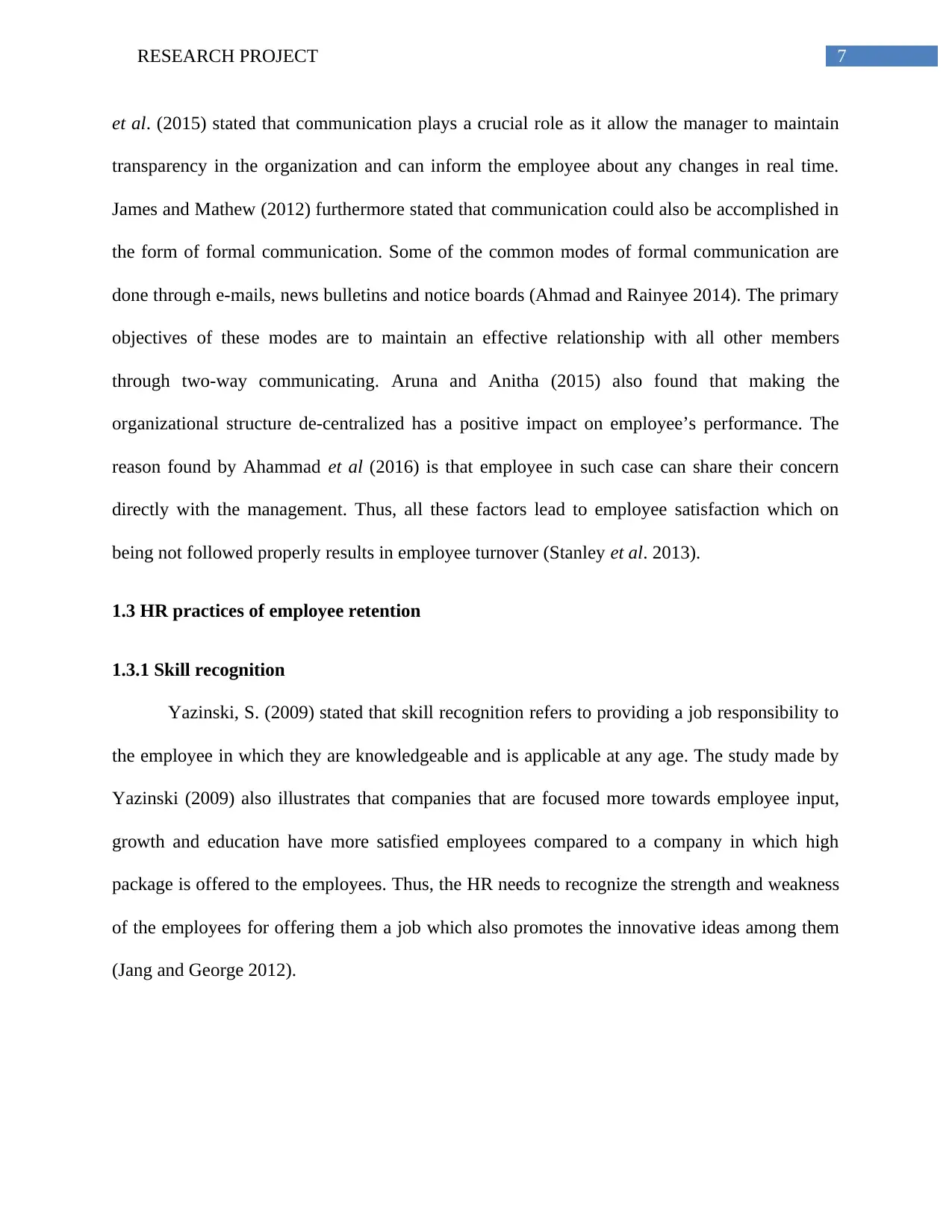
7RESEARCH PROJECT
et al. (2015) stated that communication plays a crucial role as it allow the manager to maintain
transparency in the organization and can inform the employee about any changes in real time.
James and Mathew (2012) furthermore stated that communication could also be accomplished in
the form of formal communication. Some of the common modes of formal communication are
done through e-mails, news bulletins and notice boards (Ahmad and Rainyee 2014). The primary
objectives of these modes are to maintain an effective relationship with all other members
through two-way communicating. Aruna and Anitha (2015) also found that making the
organizational structure de-centralized has a positive impact on employee’s performance. The
reason found by Ahammad et al (2016) is that employee in such case can share their concern
directly with the management. Thus, all these factors lead to employee satisfaction which on
being not followed properly results in employee turnover (Stanley et al. 2013).
1.3 HR practices of employee retention
1.3.1 Skill recognition
Yazinski, S. (2009) stated that skill recognition refers to providing a job responsibility to
the employee in which they are knowledgeable and is applicable at any age. The study made by
Yazinski (2009) also illustrates that companies that are focused more towards employee input,
growth and education have more satisfied employees compared to a company in which high
package is offered to the employees. Thus, the HR needs to recognize the strength and weakness
of the employees for offering them a job which also promotes the innovative ideas among them
(Jang and George 2012).
et al. (2015) stated that communication plays a crucial role as it allow the manager to maintain
transparency in the organization and can inform the employee about any changes in real time.
James and Mathew (2012) furthermore stated that communication could also be accomplished in
the form of formal communication. Some of the common modes of formal communication are
done through e-mails, news bulletins and notice boards (Ahmad and Rainyee 2014). The primary
objectives of these modes are to maintain an effective relationship with all other members
through two-way communicating. Aruna and Anitha (2015) also found that making the
organizational structure de-centralized has a positive impact on employee’s performance. The
reason found by Ahammad et al (2016) is that employee in such case can share their concern
directly with the management. Thus, all these factors lead to employee satisfaction which on
being not followed properly results in employee turnover (Stanley et al. 2013).
1.3 HR practices of employee retention
1.3.1 Skill recognition
Yazinski, S. (2009) stated that skill recognition refers to providing a job responsibility to
the employee in which they are knowledgeable and is applicable at any age. The study made by
Yazinski (2009) also illustrates that companies that are focused more towards employee input,
growth and education have more satisfied employees compared to a company in which high
package is offered to the employees. Thus, the HR needs to recognize the strength and weakness
of the employees for offering them a job which also promotes the innovative ideas among them
(Jang and George 2012).
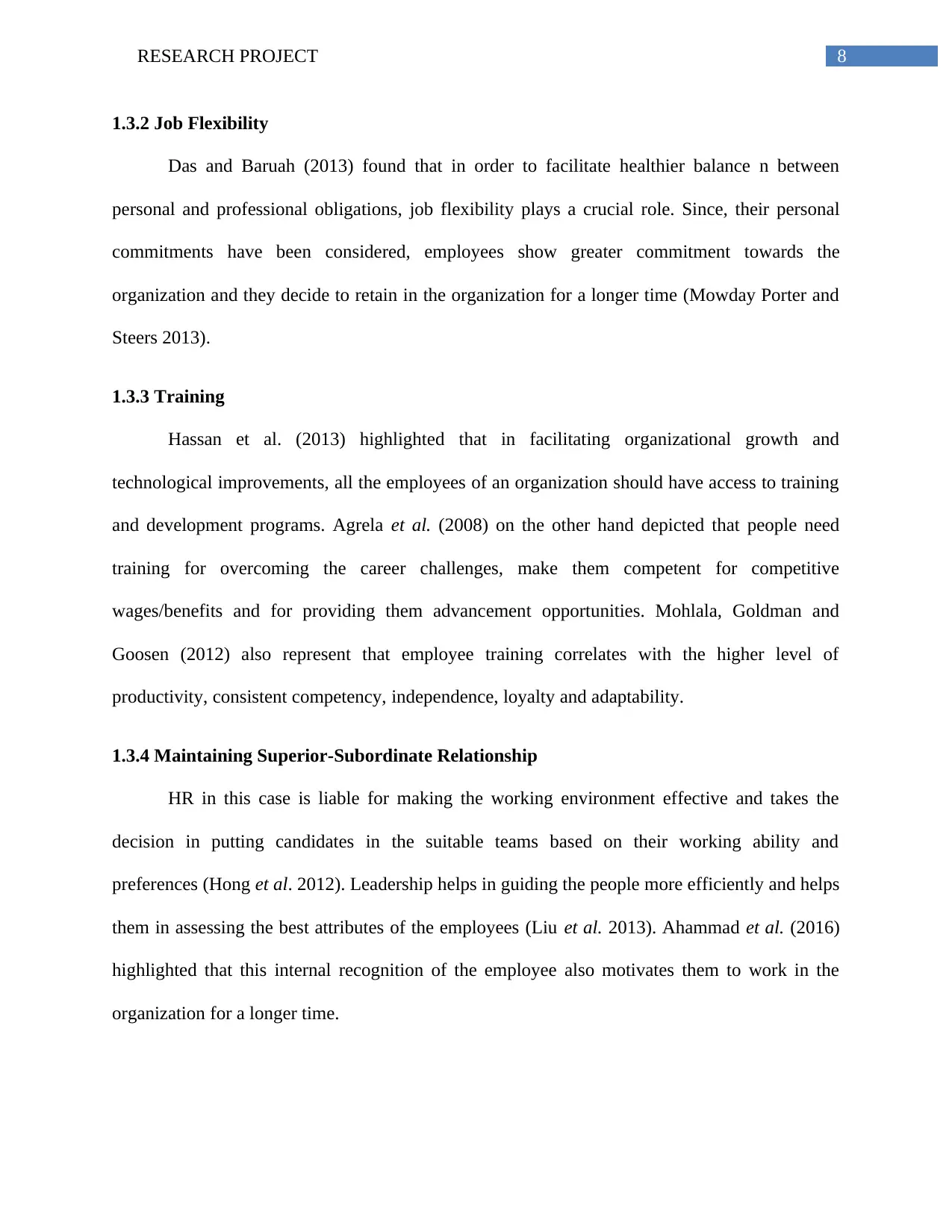
8RESEARCH PROJECT
1.3.2 Job Flexibility
Das and Baruah (2013) found that in order to facilitate healthier balance n between
personal and professional obligations, job flexibility plays a crucial role. Since, their personal
commitments have been considered, employees show greater commitment towards the
organization and they decide to retain in the organization for a longer time (Mowday Porter and
Steers 2013).
1.3.3 Training
Hassan et al. (2013) highlighted that in facilitating organizational growth and
technological improvements, all the employees of an organization should have access to training
and development programs. Agrela et al. (2008) on the other hand depicted that people need
training for overcoming the career challenges, make them competent for competitive
wages/benefits and for providing them advancement opportunities. Mohlala, Goldman and
Goosen (2012) also represent that employee training correlates with the higher level of
productivity, consistent competency, independence, loyalty and adaptability.
1.3.4 Maintaining Superior-Subordinate Relationship
HR in this case is liable for making the working environment effective and takes the
decision in putting candidates in the suitable teams based on their working ability and
preferences (Hong et al. 2012). Leadership helps in guiding the people more efficiently and helps
them in assessing the best attributes of the employees (Liu et al. 2013). Ahammad et al. (2016)
highlighted that this internal recognition of the employee also motivates them to work in the
organization for a longer time.
1.3.2 Job Flexibility
Das and Baruah (2013) found that in order to facilitate healthier balance n between
personal and professional obligations, job flexibility plays a crucial role. Since, their personal
commitments have been considered, employees show greater commitment towards the
organization and they decide to retain in the organization for a longer time (Mowday Porter and
Steers 2013).
1.3.3 Training
Hassan et al. (2013) highlighted that in facilitating organizational growth and
technological improvements, all the employees of an organization should have access to training
and development programs. Agrela et al. (2008) on the other hand depicted that people need
training for overcoming the career challenges, make them competent for competitive
wages/benefits and for providing them advancement opportunities. Mohlala, Goldman and
Goosen (2012) also represent that employee training correlates with the higher level of
productivity, consistent competency, independence, loyalty and adaptability.
1.3.4 Maintaining Superior-Subordinate Relationship
HR in this case is liable for making the working environment effective and takes the
decision in putting candidates in the suitable teams based on their working ability and
preferences (Hong et al. 2012). Leadership helps in guiding the people more efficiently and helps
them in assessing the best attributes of the employees (Liu et al. 2013). Ahammad et al. (2016)
highlighted that this internal recognition of the employee also motivates them to work in the
organization for a longer time.
⊘ This is a preview!⊘
Do you want full access?
Subscribe today to unlock all pages.

Trusted by 1+ million students worldwide
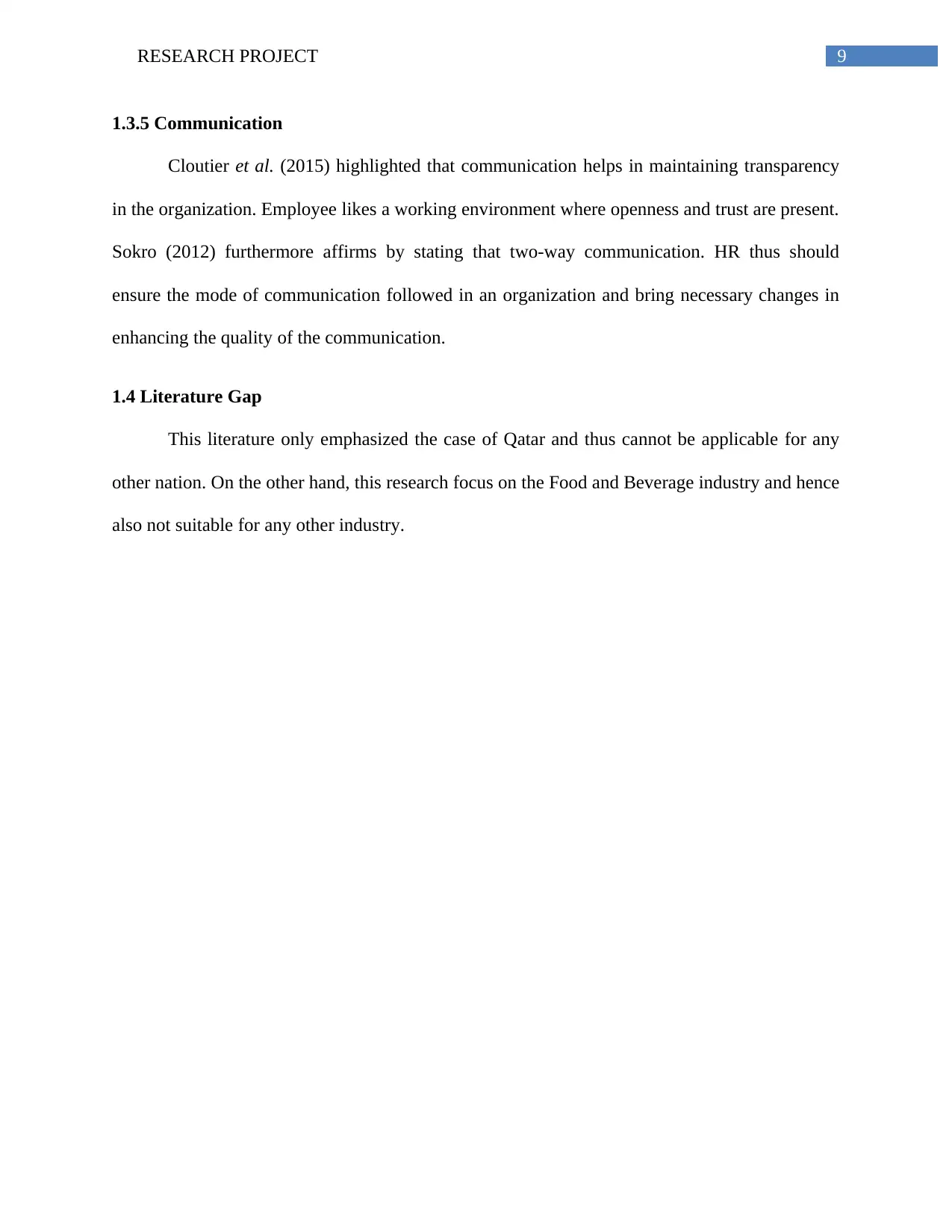
9RESEARCH PROJECT
1.3.5 Communication
Cloutier et al. (2015) highlighted that communication helps in maintaining transparency
in the organization. Employee likes a working environment where openness and trust are present.
Sokro (2012) furthermore affirms by stating that two-way communication. HR thus should
ensure the mode of communication followed in an organization and bring necessary changes in
enhancing the quality of the communication.
1.4 Literature Gap
This literature only emphasized the case of Qatar and thus cannot be applicable for any
other nation. On the other hand, this research focus on the Food and Beverage industry and hence
also not suitable for any other industry.
1.3.5 Communication
Cloutier et al. (2015) highlighted that communication helps in maintaining transparency
in the organization. Employee likes a working environment where openness and trust are present.
Sokro (2012) furthermore affirms by stating that two-way communication. HR thus should
ensure the mode of communication followed in an organization and bring necessary changes in
enhancing the quality of the communication.
1.4 Literature Gap
This literature only emphasized the case of Qatar and thus cannot be applicable for any
other nation. On the other hand, this research focus on the Food and Beverage industry and hence
also not suitable for any other industry.
Paraphrase This Document
Need a fresh take? Get an instant paraphrase of this document with our AI Paraphraser
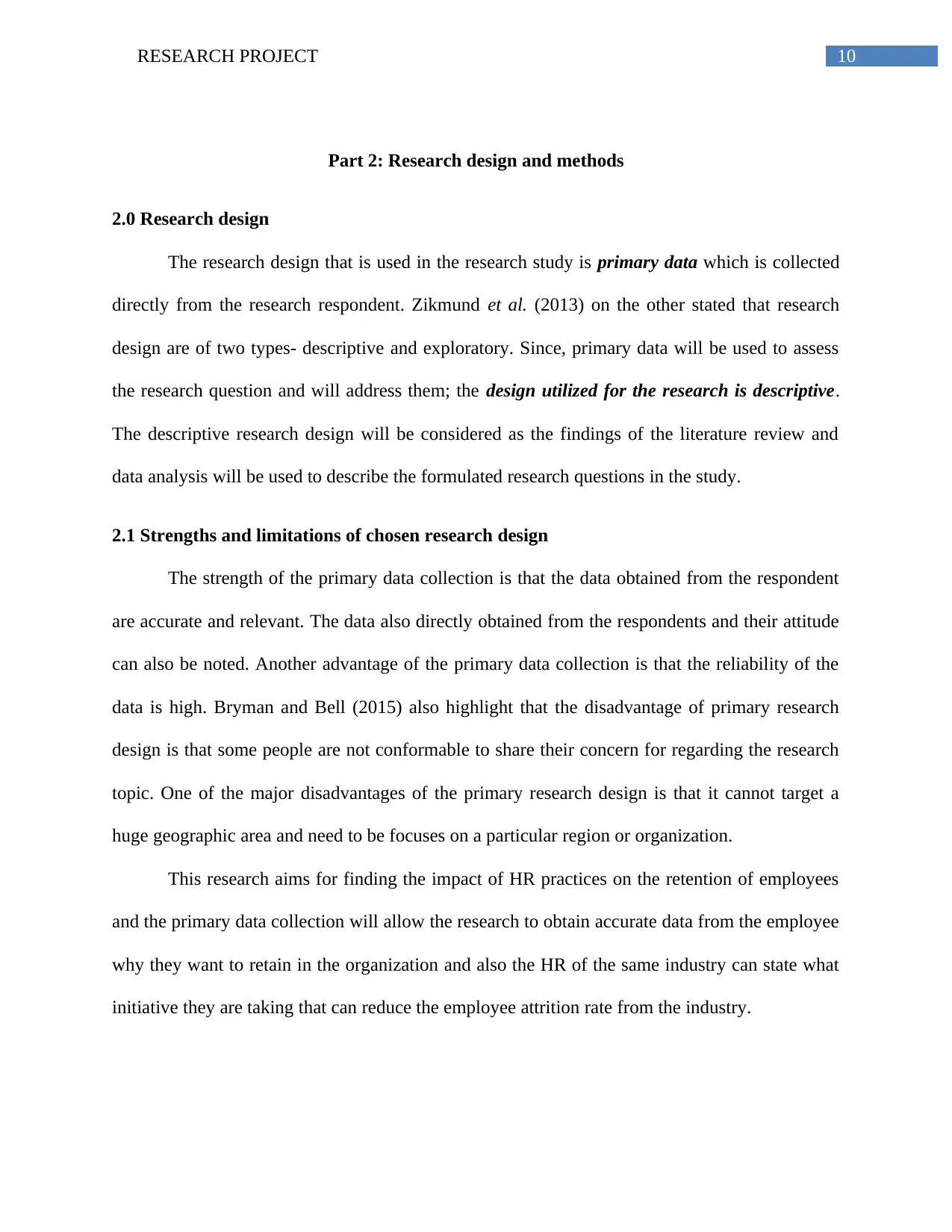
10RESEARCH PROJECT
Part 2: Research design and methods
2.0 Research design
The research design that is used in the research study is primary data which is collected
directly from the research respondent. Zikmund et al. (2013) on the other stated that research
design are of two types- descriptive and exploratory. Since, primary data will be used to assess
the research question and will address them; the design utilized for the research is descriptive.
The descriptive research design will be considered as the findings of the literature review and
data analysis will be used to describe the formulated research questions in the study.
2.1 Strengths and limitations of chosen research design
The strength of the primary data collection is that the data obtained from the respondent
are accurate and relevant. The data also directly obtained from the respondents and their attitude
can also be noted. Another advantage of the primary data collection is that the reliability of the
data is high. Bryman and Bell (2015) also highlight that the disadvantage of primary research
design is that some people are not conformable to share their concern for regarding the research
topic. One of the major disadvantages of the primary research design is that it cannot target a
huge geographic area and need to be focuses on a particular region or organization.
This research aims for finding the impact of HR practices on the retention of employees
and the primary data collection will allow the research to obtain accurate data from the employee
why they want to retain in the organization and also the HR of the same industry can state what
initiative they are taking that can reduce the employee attrition rate from the industry.
Part 2: Research design and methods
2.0 Research design
The research design that is used in the research study is primary data which is collected
directly from the research respondent. Zikmund et al. (2013) on the other stated that research
design are of two types- descriptive and exploratory. Since, primary data will be used to assess
the research question and will address them; the design utilized for the research is descriptive.
The descriptive research design will be considered as the findings of the literature review and
data analysis will be used to describe the formulated research questions in the study.
2.1 Strengths and limitations of chosen research design
The strength of the primary data collection is that the data obtained from the respondent
are accurate and relevant. The data also directly obtained from the respondents and their attitude
can also be noted. Another advantage of the primary data collection is that the reliability of the
data is high. Bryman and Bell (2015) also highlight that the disadvantage of primary research
design is that some people are not conformable to share their concern for regarding the research
topic. One of the major disadvantages of the primary research design is that it cannot target a
huge geographic area and need to be focuses on a particular region or organization.
This research aims for finding the impact of HR practices on the retention of employees
and the primary data collection will allow the research to obtain accurate data from the employee
why they want to retain in the organization and also the HR of the same industry can state what
initiative they are taking that can reduce the employee attrition rate from the industry.
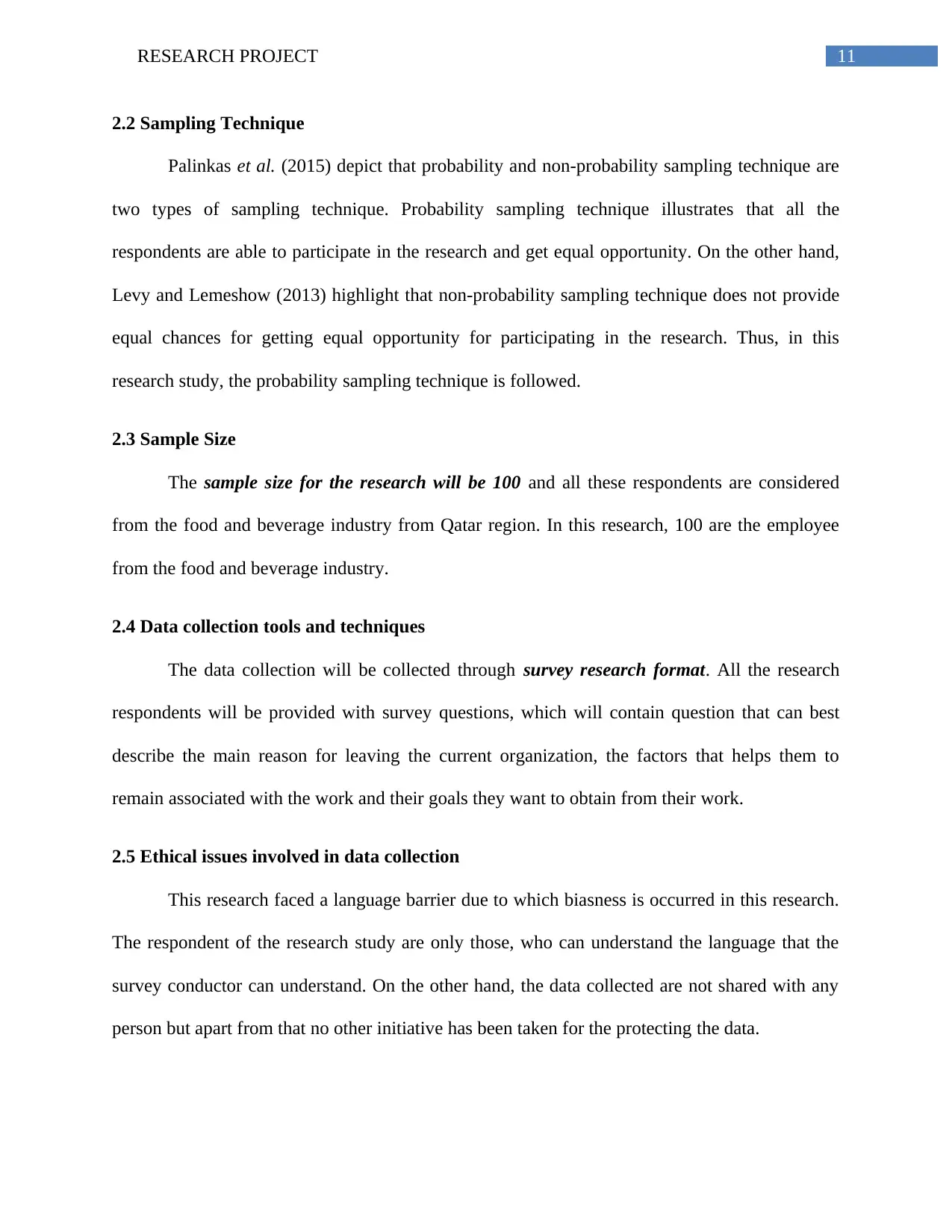
11RESEARCH PROJECT
2.2 Sampling Technique
Palinkas et al. (2015) depict that probability and non-probability sampling technique are
two types of sampling technique. Probability sampling technique illustrates that all the
respondents are able to participate in the research and get equal opportunity. On the other hand,
Levy and Lemeshow (2013) highlight that non-probability sampling technique does not provide
equal chances for getting equal opportunity for participating in the research. Thus, in this
research study, the probability sampling technique is followed.
2.3 Sample Size
The sample size for the research will be 100 and all these respondents are considered
from the food and beverage industry from Qatar region. In this research, 100 are the employee
from the food and beverage industry.
2.4 Data collection tools and techniques
The data collection will be collected through survey research format. All the research
respondents will be provided with survey questions, which will contain question that can best
describe the main reason for leaving the current organization, the factors that helps them to
remain associated with the work and their goals they want to obtain from their work.
2.5 Ethical issues involved in data collection
This research faced a language barrier due to which biasness is occurred in this research.
The respondent of the research study are only those, who can understand the language that the
survey conductor can understand. On the other hand, the data collected are not shared with any
person but apart from that no other initiative has been taken for the protecting the data.
2.2 Sampling Technique
Palinkas et al. (2015) depict that probability and non-probability sampling technique are
two types of sampling technique. Probability sampling technique illustrates that all the
respondents are able to participate in the research and get equal opportunity. On the other hand,
Levy and Lemeshow (2013) highlight that non-probability sampling technique does not provide
equal chances for getting equal opportunity for participating in the research. Thus, in this
research study, the probability sampling technique is followed.
2.3 Sample Size
The sample size for the research will be 100 and all these respondents are considered
from the food and beverage industry from Qatar region. In this research, 100 are the employee
from the food and beverage industry.
2.4 Data collection tools and techniques
The data collection will be collected through survey research format. All the research
respondents will be provided with survey questions, which will contain question that can best
describe the main reason for leaving the current organization, the factors that helps them to
remain associated with the work and their goals they want to obtain from their work.
2.5 Ethical issues involved in data collection
This research faced a language barrier due to which biasness is occurred in this research.
The respondent of the research study are only those, who can understand the language that the
survey conductor can understand. On the other hand, the data collected are not shared with any
person but apart from that no other initiative has been taken for the protecting the data.
⊘ This is a preview!⊘
Do you want full access?
Subscribe today to unlock all pages.

Trusted by 1+ million students worldwide
1 out of 23
Related Documents
Your All-in-One AI-Powered Toolkit for Academic Success.
+13062052269
info@desklib.com
Available 24*7 on WhatsApp / Email
![[object Object]](/_next/static/media/star-bottom.7253800d.svg)
Unlock your academic potential
Copyright © 2020–2025 A2Z Services. All Rights Reserved. Developed and managed by ZUCOL.





